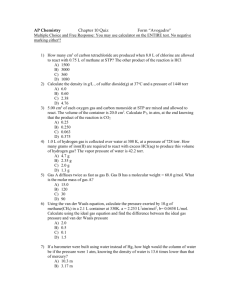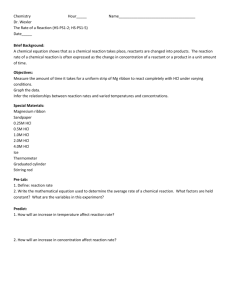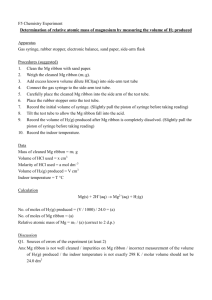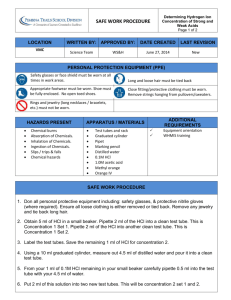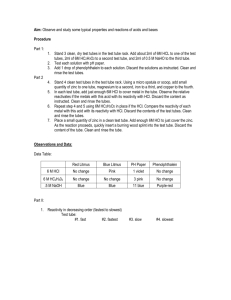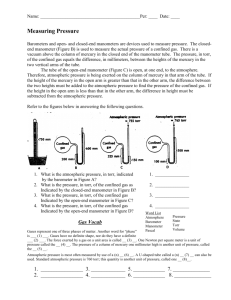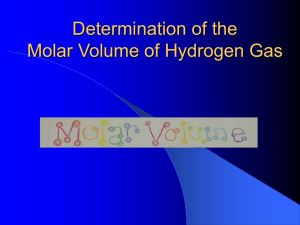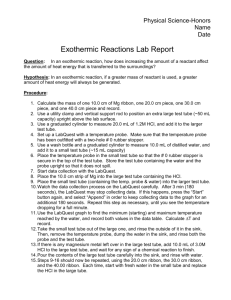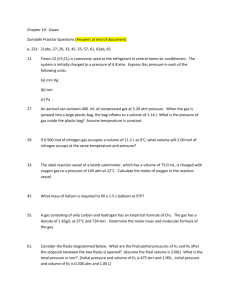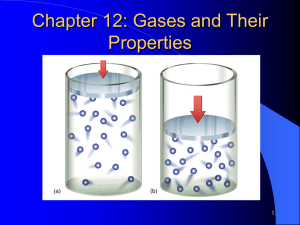WORD
advertisement
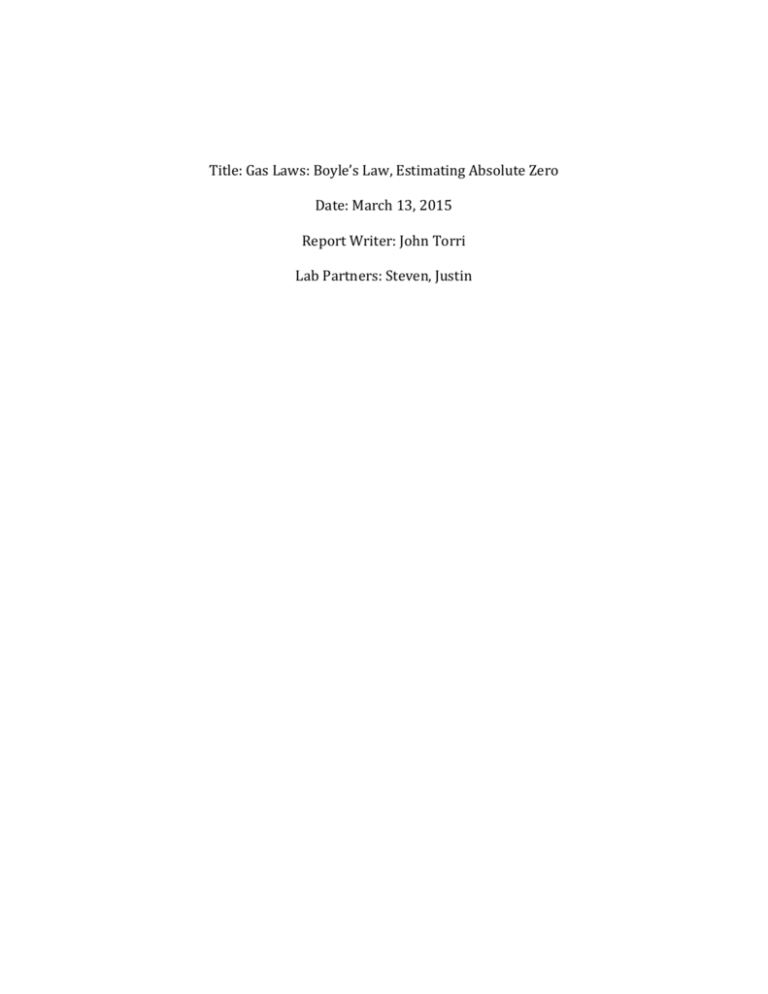
Title: Gas Laws: Boyle’s Law, Estimating Absolute Zero Date: March 13, 2015 Report Writer: John Torri Lab Partners: Steven, Justin Abstract In this experiment we tested and identified the different components that make up a gas. Including Volume, Temperature, Pressure, and Moles. Using different experiments and measurement equipment we were able to identify the components of the gas. With this information we can determine the ideal gas constant. Materials Lab Quest tool Beaker Mg Ribbon Procedure: Part 1. The goal of Part 1 was to determine the relationship between the pressure and the volume of a confined gas when the temperature is constant, and to experimentally estimate the temperature of absolute zero. Using a syringe connected to a LabQuest pressure sensor we measured the gasses pressure at 7 different points and recorded them in our post lab. Based on the data gathered we saw the correlation between the pressure at different volumes. As the volumes got larger the pressure decreased confirming Boyle’s Law. Pressure (torr) Table 1. Relationship between Volumes and Pressure of a Gas 1600 1400 1200 1000 800 600 400 200 0 Volume (ml) 10 5 7.5 12.5 15 17.5 20 Volume (ml) Figure 1.1) Table 1. Displays the correlation of different pressures (torr) at different volumes (ml). Pressure (torr) Table 2. Relationship between Pressure and Volume 1600 1400 1200 1000 800 600 400 200 0 20 17.5 15 Volume (ml) 12.5 10 Figure 1.2) Table 2. Displays a reverse measurement of the change in volume (ml) and the pressure change (torr). Part 3. The goal of part three was to measure the value of the Ideal Gas Constant. Formula. Using a strip of Mg ribbon (3cm) we added 3M HCl solution (20ml) to the Graduated cylinder until it reached the 40ml mark. Once the HCL solution is combined with the water we then added the Mg strip in the tube then added the stopper to close off the tube. Immersing the tube in the graduated cylinder. Within a minute the Mg ribbon reacts and disappears in the solution. We recorded the mass of the Mg Ribbon, the water temperature of the Graduated cylinder, Volume, and determined the pressure of the reaction. Using the data we gathered we were then able to calculate gas constant, R in L atm moleK. Our results told us that R= .0894atmL/moleK. Part 4. In Part four the objective was to investigate the relative rates at which two gases of different molar masses diffuse, and to compare the observed relative rates with that predicted by Graham’s Law. Using a 24 inch tube, and a Q-tip (broken in half), and two small one hole stoppers. Each half of the Q-tip was dipped in either an acid (HCl)or a base (NH4OH). Then simultaneously placed on either sides of the 24 inch tube, we waited until a faint white line formed on the tube. Once the line formed we measured the distance from the tip of the Q-tip on each end. Using this ratio we plugged it to Grahams formula. We divided the distance of MM(HCl)/MM(NH4OH) and received the value of 1.24cm. Calculations: Part 1. (Boyle’s Law) Volume (ml) Pressure (torr) 10 768.7 5 1490.1 7.5 1004.1 12.5 618.7 15 517.7 17.5 444.8 20 391.3 Volume (mL) 20 17.5 15 12.5 10 Pressure (torr) 767.3 873.1 1015.5 1208.6 1492.7 Part 3. (Ideal Gas Law) Mg Mass: .0035g -> 1mole Mg/ 29.31g= .0014M Mg Volume= 36.9mL/1000L = .0369L Pressure= 755.3torr-> 1 atm/760torr= .994 atm Temp= 21 C (21+273= 294K) P= (.994 atm) x V= (.0369L)/ (M=.0014) x (T=294K) .0894 atmL/Mole K Part 4. (Graham’s Law) Distance of HCl: 16.9cm Distance of NH4OH: 21.0cm Ratio: 21cm(NH4OH)/ 16.9cm (HCl) = 1.24cm Conclusions: This lab solidified and supported the laws and rules we have learned throughout our classes. Using Boyle’s Law in we saw in this experiment how Volume and pressure were directly related and how the larger volume objects had a lower amount of pressure. Part three of the lab showed the ideal gas law and how the different components of V,P, n, T can be used in the Ideal Gas formula to find the missing variable. Part four dealt with Grahams law, measuring the distances of each gas and determining the square root of their molar masses, both at the same temp, and pressure. In conclusion, all of these law’s and formulas helped to identify these gasses and determine other information in relation to each formula.
